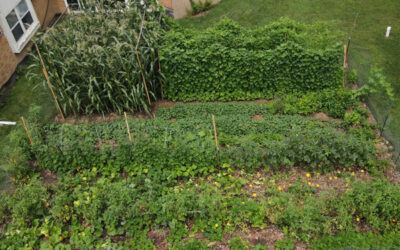So what’s truly new about the GFS? It certainly isn’t home food gardens per se, or that they can produce abundantly. Rather, the novelty revolves around subsistence self-sufficiency gardens that:
- Require just 1% of the three acres it takes the IFS to feed a person for a year
- Can quickly and easily scale up to providing much to most of the nation’s food supply
- Rely on simple gardening methods and consumer values that cannot be disempowered or appropriated by the IFS.
Right, that’s altogether quite a novel proposition. Yet manifesting it is eminently feasible, as you will see. That said, first let’s further describe these components.
Efficient subsistence home food gardening
The idea here is growing food to meet all your nutritional needs for a meal, a day, a month, or any period up to a year on just 1% of the three acre “food footprint” it takes the IFS to feed you. That means supplying not just vitamins and minerals from the usual watery tomatoes, green beans, kale, squash, and the like, but also meeting calorie and protein needs from energy-dense staples like corn and beans. If for a year, it needs to be accomplished on a relatively small plot (e.g., 35’ x 40’) that can be easily gardened by an average person with an hour or so of enjoyable activity per day. Which I’ve shown is doable, even with what many would call significant constraints:

Since this means that three acres of self-sufficiency gardens can feed 100 people, whereas three acres of the IFS feeds just one person, I will hereafter refer to this ratio as the Factor One Hundred.
Ramping quickly and easily up to large scale production
By this I mean being able to provide at first some, then much to most of the country’s food needs, depending on where the GFS is in its development. In other words, not just approaching but surpassing the scale of the victory gardens in the U.S. or providing half of Russia’s food on 3% of its agricultural land, to give just a couple examples. As for speed and ease, recall that in WWII amateurs turned out 40% of U.S. vegetables on 20 million gardens within a couple years of start-up. The fact that those gardens took off like a rocket shows—ironically—that it’s not exactly rocket science.
Catering to universal customer values that cannot be disempowered of appropriated by the industrial system
The reason the IFS has such a stranglehold on the food supply it that it has hooked us on cheap and seemingly convenient food. Which is mostly unhealthy and is produced by unsustainable means, to boot. By contrast, a variety of alternative, more sustainable agricultural practices—while highly laudable—have never accounted for more than about 1% of U.S. food sales. Okay, organic has now hit about 6%, but mostly as “industrial organic” that blends right into the IFS, thereby supporting most of its unsustainable features. Shrink-wrapped, microwavable, frozen organic pizza, anyone? And why have sustainable alternative systems consistently hit that 1% ceiling? Because they, unlike the IFS, cannot externalize the lion’s share of their costs. Hence they can’t compete with the artificially low prices in the supermarket.
 Home food gardens, on the other hand, operate outside of the IFS by catering to an entirely different set of values, one that that we all (often unconsciously) have, and which gardeners automatically engage: connection to the earth, ourselves, and one another. A survey by the National Gardening Association found that only about 15% of gardeners’ motivations for growing their own food is to save money. The other 85% is to enjoy the benefits of better taste, quality, and safety; feel productive; spend time outdoors; get back to basics; share food with others; live more locally; enjoy family activity; and teach kids about gardening. These benefits are a reliable result of enjoyable hands-on gardening. The IFS cannot duplicate, or even approach, that degree of connection.
Home food gardens, on the other hand, operate outside of the IFS by catering to an entirely different set of values, one that that we all (often unconsciously) have, and which gardeners automatically engage: connection to the earth, ourselves, and one another. A survey by the National Gardening Association found that only about 15% of gardeners’ motivations for growing their own food is to save money. The other 85% is to enjoy the benefits of better taste, quality, and safety; feel productive; spend time outdoors; get back to basics; share food with others; live more locally; enjoy family activity; and teach kids about gardening. These benefits are a reliable result of enjoyable hands-on gardening. The IFS cannot duplicate, or even approach, that degree of connection.
Now, it’s not that upon hearing my message everyone will suddenly get all starry-eyed about gardening and leave the supermarket behind. But some will, and then more and more. Remember that the IFS is basically money-motivated (though there’s nothing intrinsically wrong with paying for something) whereas the GFS is almost entirely connectivity-energized. Ramping up the GFS is largely a matter of more fully engaging peoples’ often long-missed connectivity cravings. Of course, that will require a full-out national promotional campaign to counter the $billions spent by the IFS to convince people to consume mostly highly processed food. But it can be done.
And finally, because gardeners have complete control of what they grow, the GFS cannot be disempowered or appropriated by the IFS. Even people in community gardens, which some without access to their own sunny garden plot will need to use, will have full control over their gardening decisions.
What follows is a summary on my take on how diffusion of innovation relates to the GFS. I used Wikipedia as a guide, and for sure it will be continually updated and improved once it’s launched. To make it easy to scan, I’ve employed bullet point lists liberally.
Elements of diffusion
Characteristics of innovations
In general, the GFS enterprise meets the standard criteria of a genuine innovation, as it features:
- A considerable gain of efficiency (Factor One Hundred)
- Compatibility with the previously existing system (40% of U.S. households already have self-sufficiency gardens)
- Ease of adoption (quick U.S. victory gardens scale-up)
- Ease of testability (USDA’s victory gardens data set)
- Potential for continued development and improvement (adapting/updating the many gardening methods)
- Easily observed effects (as with any well-tended garden)
- Feature a small core and large periphery (core is existing gardeners, building up with peripheral new adopters)
- Is not disruptive to routine tasks (requires an hour a day [properly done] of easy, enjoyable activity)
Lack of significant barriers
What accounts for successful innovations? One crucial element is that there’s nothing formidable enough to pose a threat to broad acceptance. Easy is a key.
- In fact, self-sufficiency gardens make the task of meeting national targets for food security far easier (Russia, victory garden examples) than trying to re-imagine the IFS or scale up sustainable agriculture.
- It’s relatively simple for aspiring gardeners to learn (short victory garden learning curve)
- Prior adopters (current gardeners) are likely to support their kindred spirits: new gardeners.
- Community gardens are often either already available or can be started up for those who don’t have an appropriate plot of land. The American Community Gardening Association will help.
- What about perceived barriers that are not significant? For instance, “Who has the time?” (This despite the average American spending four hours a day watching TV, while I’ve demonstrated that a one-year subsistence garden averages an investment of about an hour a day.) Chapter 6 of Just Grow It Yourself discusses such common misperceptions about gardening. That said, perceived barriers can be formidable hinderances for a newbie until the invalid assumptions behind them are convincingly dissolved. Nevertheless, they are not truly significant barriers to the diffusion of innovation, as is (again) indicated by the quick implementation of 20 million victory gardens in WWII.
Characteristics of individual garden adopters
“Google search interest in “raising chickens” has jumped markedly from a year ago. The shift is part of a broader phenomenon: A small but rapidly growing slice of the American population has become interested in growing and raising food at home, a trend that was nascent before the pandemic and that has been invigorated by the shortages it spurred.” — NY Times Feb. 2, 2023
Research has shown that when a new idea is introduced to a community, the first people who adopt it exhibit a predictable set of character traits. This was certainly true for one of the first-studied instances of diffusion of innovation: the introduction of hybrid corn seed to the farming community of Iowa in the 1940s. Some farmers, because of their innate tendencies—more readily motivated, metropolitan, and empowered—picked it up more quickly than others. For gardeners, the first adopters tend to be those who:
- Are most open to change and new ideas, especially those that center around increasing connectivity to themselves and their surroundings
- Are more likely to live in urban and suburban areas, which is where most self-sufficiency gardens are located. Surprisingly, rural people are on average among the later adopters.
- Have the power or agency to create change, not incidentally true here of almost anyone who has a lawn, which 80% of U.S. households have. This doesn’t mean that people who have lawns are inherently more likely to start a garden than those who don’t. Just that if they have one, they have the wherewithal—land, greater ability to procure gardening supplies, etc.—to do so.
The process of diffusion
As with all new adopters, gardening beginners will go through the process of:
- Learning about the advantages of a self-sufficiency garden
- Becoming intrigued by the prospect of enjoyably supplying oneself with up to a year’s worth of healthy food
- Deciding to try it out
- Following through with a trial self-sufficiency garden
- Adopting self-sufficiency gardening as an ongoing habit
All of these steps must be incentivized by campaigns to compellingly counter the $billions in advertising driving the narrative that the IFS is the only way to go. That narrative did not happen accidentally or by default. Rather, it’s the result of decades of highly focused industry efforts. An equally effective (though not so costly) GFS repost is in order.
Decisions
Most important about deciding to start a garden is that it be done freely, implemented voluntarily, and enjoyed. The decision cannot be imposed by those in positions of power or influence (including parents), or by a collective, even if democratically voted on. For gardening to work at all, the decision to do it must be made by the individual; disgruntled gardening, especially by kids, is a non-starter. Friendly, respectful enticing and encouraging, however, is very much in order.





0 Comments